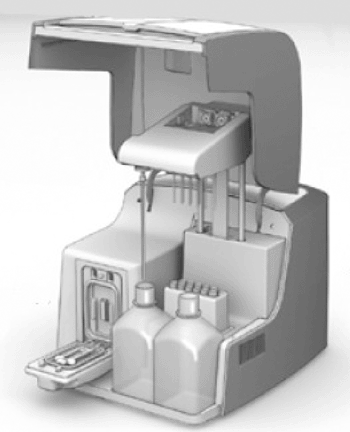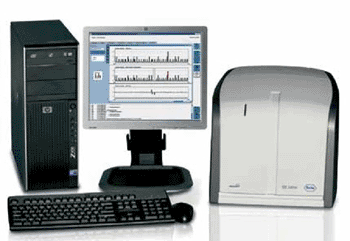Benchtop DNA Sequencing System Anchors Development of Personalized Cancer Treatment
By LabMedica International staff writers
Posted on 30 Jan 2012
A new top-of-the-line benchtop DNA sequencing system has been used to identify genomic variations in solid tumors, a methodology needed for development of personalized anticancer treatments.Posted on 30 Jan 2012
Studies at the Center for Human Genetics and Laboratory Medicine (Martinsried Germany) and IMGM Laboratories (Martinsried Germany) were carried out using the new Roche (Basel, Switzerland) GS Junior Benchtop System.
The GS Junior System supports the sequencing of samples from a wide variety of starting materials including genomic DNA and PCR products. Samples such as genomic DNA are randomly fragmented into small, 300- to 800-basepair pieces. For smaller samples, such as small non-coding RNA or PCR amplicons, fragmentation is not required.
Using a series of standard molecular biology techniques, short DNA adaptors are added to each library fragment. These adaptors are then used in subsequent quantification, amplification, and sequencing steps. The single-stranded DNA library is immobilized onto specifically designed DNA capture beads. Each bead carries a unique single-stranded DNA library fragment. The bead-bound library is emulsified with amplification reagents in a water-in-oil mixture resulting in microreactors containing just one bead with one unique sample-library fragment.
Each unique sample library fragment is clonally amplified within its own microreactor, excluding competing or contaminating sequences. Amplification of the entire fragment collection is carried out in parallel; for each fragment, this produces several million copies of the original fragment per bead. Subsequently, the emulsions are broken to facilitate collection of the amplified fragments bound to their specific beads.
The clonally amplified fragments are enriched and loaded onto a PicoTiterPlate device for sequencing. The diameter of the PicoTiterPlate wells allows for only one bead per well. After addition of sequencing enzymes and reagents, the fluidics subsystem of the Genome Sequencer System serially flows nucleotides in a fixed order (i.e., first T, then A, and so on) across the hundreds of thousands of wells containing one bead each. Addition of one (or more) nucleotide(s) complementary to the template strand results in a chemiluminescent signal recorded by the CCD camera of the Genome Sequencer System. The intensity of the resulting signal is proportional to the number of bases incorporated.
The combination of signal intensity and positional information generated across the PicoTiterPlate device allows the software to determine the sequence of 100,000 individual reads per 10-hour instrument run simultaneously. For sequencing data analysis, three different bioinformatics tools are supplied that readily support the following applications: de novo genome assembly up to 3 Gb; resequencing/mapping genomes of any size; and amplicon variant detection by comparison with a known reference sequence.
The GS Junior system weighs in at only 25 kg and is 40 cm wide x 60 cm deep x 40 cm high (about the size of a laser printer). Despite this small footprint, the GS junior encompasses all the power of Roche’s 454 sequencing technology.
“The future of personalized tumor treatment lies in this sequencing approach,” said Dr. Hanns-Georg Klein, CEO of both IMGM and the Center for Human Genetics and Laboratory Medicine. “Through our research, we have found that it is critical to ensure a comprehensive analysis of a tumor variant population, including known and novel mutations.”
Related Links:
Center for Human Genetics and Laboratory Medicine
IMGM Laboratories
Roche















